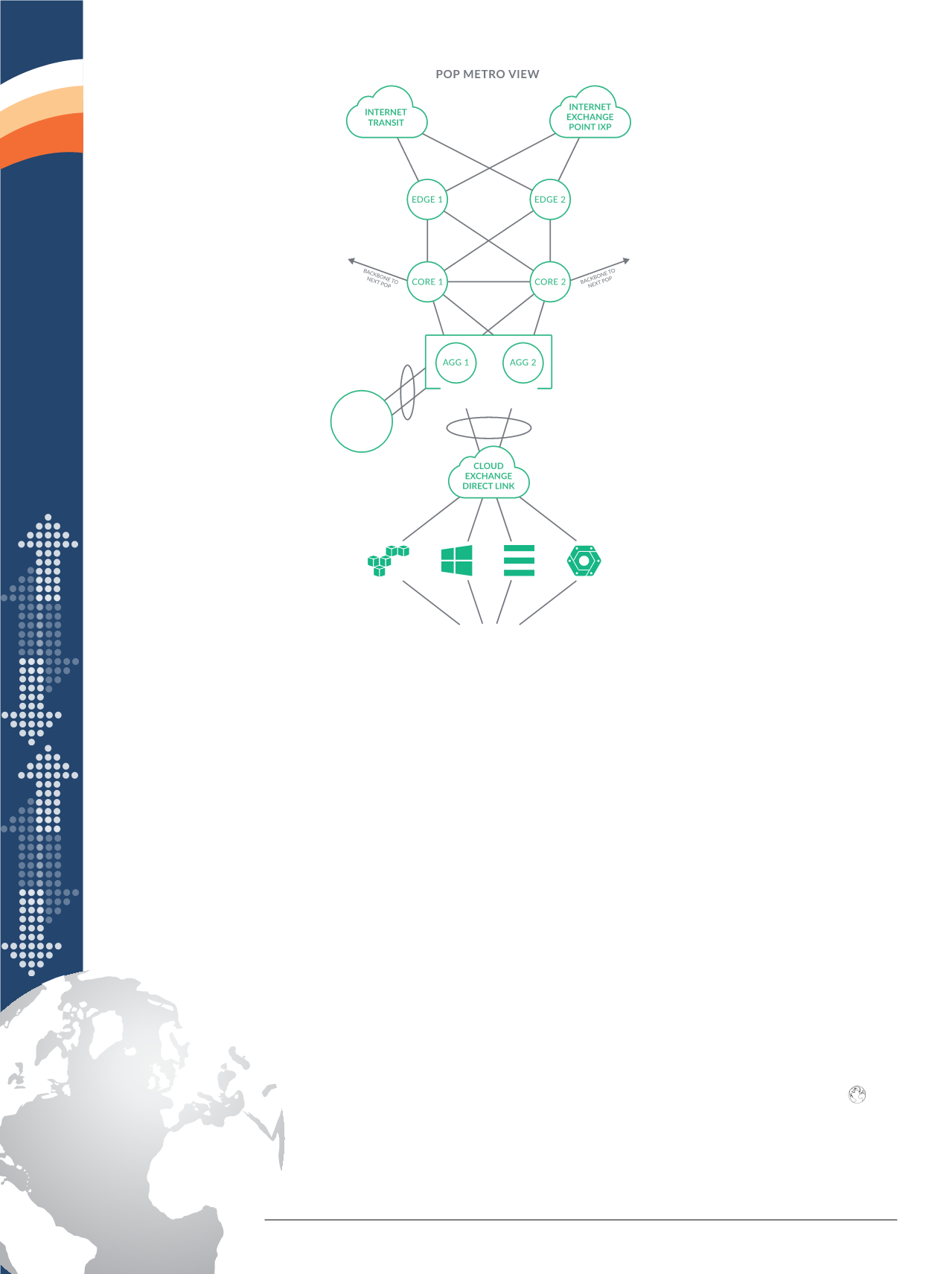

that customers will ingress at the
closest PoP (i.e., customers lo-
cated on the West Coast will have
a high probability of ingressing at
San Francisco or Seattle). If the
desired service is at each location,
the traffic will be handled locally,
or will route to the nearest PoP
across the backbone.
One of the keys to establish-
ing this environment is peering on
an Internet exchange point (IXP).
When an IXP link is established,
networks can peer with other IXP
networks in a given region. This
method allows companies that
exchange significant traffic to form
a peering relationship over the
exchange, resulting in direct traffic
exchanges between the networks
and thus eliminating the need
to rely on costly Internet transit.
Another option is to form a direct
connection within the same carri-
er-neutral facility if private peering
is desired.
This is just one example of a
strategy that can be used to build
a global IP backbone with multiple
PoPs, peering arrangements and
connectivity options to increase per-
formance and routing visibility on
the Internet. The end result enables
you to be closer to your customers
and partners, leading to higher ser-
vice quality and reduced costs.
Cloud-Agnostic Data
Centers
The classic approach to networking
typically involves building facilities with
cages and rows of bare-metal servers
and network gear to establish con-
nectivity. An alternative is to use cloud
service providers as the new data cen-
ter. Using a small footprint of network
hardware and direct connections, orga-
nizations can build IP backbones that
establish routing with cloud providers
to route virtual networks.
Using a cloud-agnostic approach,
companies can strategically build
network PoPs within close proximity to
cloud providers offering direct cross-
connects. A simple network model can
be used to route traffic to and from a
PoP with standard Internet transit. An
edge and core layer of routers is used
to manage routing decisions at the
PoP, and an aggregation layer can be
used to establish local cross-connects
to build routing peers. This model al-
lows an organization to peer privately
with Amazon Web Services, Microsoft
Azure, IBM SoftLayer, Google Cloud
(GCE) or any other cloud provider of-
fering similar services.
Once the network is live and peer-
ing is established, the virtual network
built in the cloud is then routed using
the IP backbone of the network. A vir-
tual network in AWS East can talk to
a virtual network in Azure Central all
over the same private IP backbone, as
if those virtual networks were actual
data centers. Once this connectivity
is in place, all virtual instances within
the cloud provider are essentially just
a server within the network. Each
cloud has networking limitations that
organizations will need to creatively
work around to meet their needs, but
basic configurations, such as build-
ing NAT translations or using your
own IP space, are simple advantages
that can be implemented. This model
allows for a small and cost efficient
network footprint when compared
to building traditional data centers,
as the data center burdens are con-
sumed by the cloud provider.
Another benefit of this model is
that control of the network is main-
tained by the organization. All routing
decisions, IP space, QoS policies,
etc., can be handled within the net-
work layer, which provides additional
flexibility. Depending on the use case
of the network, the total footprint can
be as small as a single 45RU cabinet
filled with only the necessary hard-
ware needed to build the model and
establish connectivity.
So What?
During the past decade, the public
Internet and cloud computing have
truly gone global, with even the small-
est business in the most remote part
of the world leveraging the ability to
spin up compute and storage with the
likes of AWS, IBM SoftLayer, GCS or
Azure. This new ubiquitous capability,
coupled with the increasing focus on
DevOps automation and user-friendly
software applications, has deeper im-
plications for the delivery of real-time
communications over the Internet.
Quality of service and reduced
costs are the main benefits to an or-
ganization’s ability to deliver diverse,
resilient and redundant real-time com-
munications associated with the adop-
tion of these technologies. Network
automation, building select peering
relationships and deploying cloud-ag-
nostic PoPs all contribute to increased
QoS. Further, the start-up investment
cost and effort for implementing these
strategies has decreased dramatically
in recent years—and will continue to
do so in the coming decades.
Ian Reither is co-founder and COO
at Telnyx, and Jason Craft is senior net-
work engineer at the company. Learn
more at
www.telnyx.com.
D
IREC
T
C
ROS
S
C
ONNEC
T
“
TH
E NEW
D
ATA C
ENTER”
C
LOU
D
S
ERV
IC
E P
ROV
ID
ERS
INTERC
ONNEC
TION
AGGREGATION LAYER
An example multi-cloud strategy using
cloud providers as the “new data center,”
connecting directly into the
backbone network
INTERNATIONAL AGENTS
SECTION
32
CHANNEL
VISION
|
July - August 2016
















